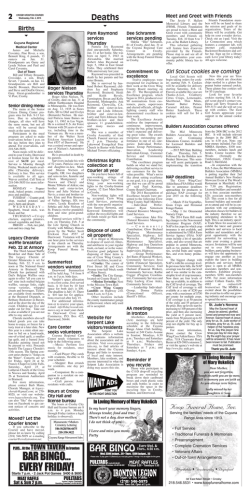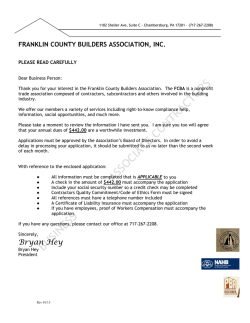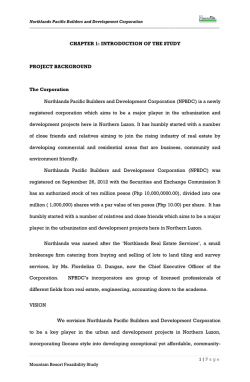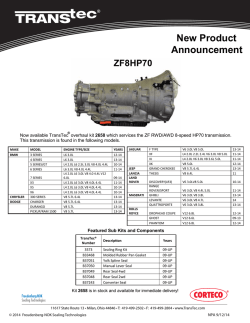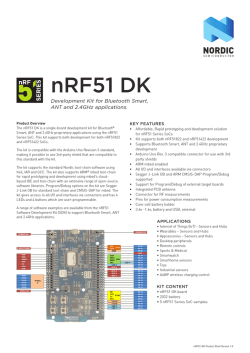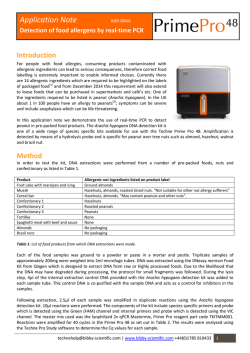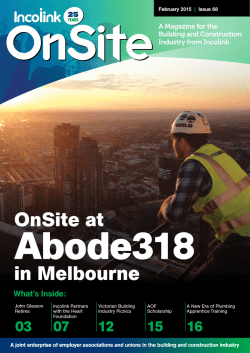
Kitplanes Template
Potential Sonex builders learn basic skills before writing a big check for a kit. By Scott M. Spangler As the builders gathered outside the warehouse hangar before the workshop began each day, Sonex Aircraft CEO Jeremy Monnett made fly-bys in the company’s different airplanes. 20 KITPLANES January 2015 www.kitplanes.com & www.facebook.com/kitplanes In the era of amateur-built Experimental aircraft kits, tackling the tail feathers seems to be the de facto subassembly on which many first-time builders base their decision to build an airplane. Sonex Aircraft offers a tail kit, said General Manager Mark Schaible, but Sonex believes a builder’s time (two days) and money ($200) are better invested by attending its builder’s workshop. There they will acquire firsthand information and explanation, as well as guided hands-on introduction to the skills needed to build the kit—and make a sound, well-informed decision. Sonex has held three such workshops, on average, every year since its founding in 1998, and like its kits, the company continually refines the event. Conducted at its three-hangar campus at Wittman Regional Airport in Oshkosh, Wisconsin, 21 builders and 14 of their guests (who participate at no cost) comprised the 57th workshop, held June 24 and 25, 2014. Both days started at 8 a.m. with Sonex CEO Jeremy Monnett making fly-bys in Sonex, Waiex, Onex, and the Sonex Sport Acro test-bed for the turbocharged AeroVee engine. Eyes skyward, the workshoppers shared which model was the focus of (or had already fulfilled) their ownership aspirations. Gathered in the Sonex Flight Center facility, Jeremy introduced most of Sonex’s 16 full-time and three part-time staffers, including founders (and parents) Sonex founder John Monnett shares the history of the company and its airplanes with the workshoppers. John and Betty, Schaible, Kerry Fores, who scratch-built a Sonex (Serial No. 9) and is the tech support department, and Chief Flight Instructor Joe Norris, who runs the T-Flight transition training program (see sidebar). With each introduction, Monnett gave examples of how customers interacted with them; “Steve Mitchell is the warehouse manager, and he’s the person who sends your shipping confirmation.” The structured workshop is composed of 24 sessions, 14 on the first day, including registration, a catered lunch, dinner on their own, and an evening session. When the workshop concluded at 4:30 p.m. on Sunday, the attendees would possess a brief history of the company and its aircraft, engines, and their design and engineering philosophy. They’d have a hands-on introduction to the necessary skills and delve into the tools and organization needed to build Most of the builders brought guests to the workshop and, assisted by Sonex General Manager Mark Schaible, they tried out the Sonex cockpit during the breaks. Photos: Scott M. Spangler an airplane, the engines that would power it, and the avionics, paint, and upholstery that would finish it. Monnett asked the builders and their guests to introduce themselves, summarize their flying experience, and where they were in the decision making process. First-time builders were the majority, and roughly a quarter of them were 40 or younger. They’d traveled to Oshkosh from the four corners of America, Guam, and the Netherlands. They were retired airline pilots, a student in training, a glider pilot, and an aviator flying again after 20 years on the ground. Their guests were brothers, sons, wives, and building buddies. During the warehouse tour, Monnett said its shelves held the parts for a dozen kits of each model. Surrounded by neat stacks of matched-hole, CNC laser-cut 6061-T6 aluminum, Chuck Sheldon offered an unexpected decision when he observed that, “You’re not buying a kit airplane, you’re buying the company and the people behind it.” He should know. For the last 18 years he’s been building a Glasair III with a 400-hp LS367-480 liquid-cooled V-8. Recently retired, his naval aviation career accounted for much of that time, including “two tours where I was unable to touch it.” Now retired to New Mexico, the Glasair is 90 percent done, he said. The guest of Richard Nicholas, who built a tube-and-fabric Rans S-6, Sheldon said both were eager to get hands-on with sheet metal because he plans to build a single-seat Onex—with a tailwheel—once he’s completed his composite Glasair. KITPLANES January 2015 21 Planned Demonstrations Work Before the workshoppers started work on their project that combined a spar, rib, and skin into a leading edge, Fores introduced them to the elegantly organized plans. Pointing to the flowchart on the flat screen monitor behind him, each drawing is a member of an inverted family tree that starts with an individual part. It works through the addition of related parts until it becomes “leading edge complete.” Each part, he explained, has a unique code. A three-letter prefix, such as SNX, identifies the model. Next is its structure such as W for wing or X for the workshop project. Finally, a unique number identifies the part, assembly, and the drawing that depicts it. SNX-X10 is the mainspar web. Attaching the mainspar caps, SNX-X09, with the only solid rivets in the kit, creates the mainspar assembly, SNX-X08. Attaching the forward wingrib, SNXX15, begets SNX-X14, and riveting the forward wingskin, SNX-X18, to this assembly gives life to SNX-X02, the completed leading edge project. Kit builders need not worry about the drawing’s minute 1/64th-inch measurements created by the CAD program’s auto dimension feature. When building the laser-cut kit, he said, “Make no assumptions when building the plane; if you have to compute a dimension, you’re making it harder than you need to.” When creating parts from raw materials, as he did, Fores said builders must Sonex technical guru Kerry Fores shows Jill Steenbergen how to flute her nose rib. make their measurements from referenced zero position to avoid “tolerance creep.” Humans with a ruler are not a CNC machine, but “the airplane will fly forever at the builder tolerances of 1/32 or 1/16.” Always use a metal ruler. Wood yardsticks are not as accurately marked and they expand and contract with humidity. When the chuckles subsided, Fores recounted several tech support calls from builders who created their problems by using them. Designed as a plansbuilt airplane, the Sonex’s 100 sheets meet the needs of scratch and kit builders alike. The other airplanes are kits only, and their page count is closer to 80. “We sell twice as many plans as kits,” said Schaible, “but no one can accurately say how many airplanes are built from raw materials.” Prospective builders examine the plans, and many of them buy full kits Centrally located supplies and spare parts served the workshoppers’ construction needs. 22 KITPLANES January 2015 months or years later; a smaller number start with raw materials. A diminishing breed, John Monnett said, “We don’t hear from them until they send a photo of the completed airplane…or they just show up at Oshkosh. Last year we had three of them.” Another benefit of the Sonex system is that builders can start work on any part at the bottom of the drawing tree, which means different builders can work on the kit concurrently. This appealed to one workshopper, Jill Steenbergen, a science, technology, engineering, and math teacher at the College Station (Texas) Independent School District. Working with EAA Chapter 1531, her engineering classes will build an airplane as part of the Sonex Education Initiative. Fores concluded his presentation with a tech support warning. “Don’t call unless you’re sitting in front of the drawing of the part in question.” And an e-mail, with photos as appropriate, is better than a call because it enables him to efficiently research the in-depth answer. As another source of building information, he recommended the independent Sonex Builders & Pilots Foundation (www.SonexFoundation.com) as a reliable source. Although there were no scratchbuilders at the workshop, John Monnett includes them in his discussion of tools, and he demonstrates the fundamental skills they’ll need. Working on a bench with an overhead camera, he cut a rib blank from a sheet of 6061-T6 aluminum www.kitplanes.com & www.facebook.com/kitplanes Chuck Sheldon holds while his building buddy Richard Nichols drills rivet holes in the spar cap. and then beat it into shape on a form block, which Sonex sells. Sonex kits ship with completely preformed ribs, but to learn a new skill—and how the aluminum reacts—the workshoppers would wield a mallet and bending and fluting pliers to form their rib from a laser-cut blank. Builders can find most of the tools they’ll need at any hardware store, Monnett said, and the complete tool list is on the Sonex web site. A nice drill is a necessity, and “you can’t have too many #40 drill bits.” A bandsaw with a 6-tooth/inch wood blade lubed with an old candle is good for cutting parts from extruded aluminum. Referencing the aviation tool suppliers, builders will need Clecoes and their pliers, left, right, and straight snips, deburring tools, and fluting pliers. “If you don’t want to look like Popeye, Harbor Freight sells an affordable pneumatic puller and compressors.” Sonex also sells several specialty tools, like an anvil for setting the solid rivets in the spar caps and a two-piece die that flanges the lightening holes in the ribs. Before the builders started on their projects after lunch, Fores urged them all to relax. Speaking from experience, he said, when creating an airplane all builders make mistakes. At the workshop, mistakes are a learning opportunity that reduces their reoccurrence. An unspoken bonus is that workshoppers don’t have to wait (or pay) for replacement parts. Most brought their own hand tools. Some dumped them on the table and others, like Ed Hidalgo, a pediatrician from Guam, laid them out just so. At first glance, his Sonex plans overwhelmed him, but after studying them for three months, he felt the project was something he could do, and the workshop revealed that the challenge was even easier. “This is play for me,” he said, working away, assisted by his wife. Ron Elza bought an untouched Sonex kit from another builder. It waits in his Texas garage, and “it was very hard to not start tinkering, to keep my hands off it until I attended the workshop.” At the same table, Scott Walby, battalion chief of the Eau Claire, Wisconsin, fire department, nodded; there’s a Onex kit in his garage. T-Flight Training More than a dozen builders participating in the builder’s workshop took the $100 introductory T-Flight lesson in the Sonex model they planned to build. Sonex introduced its transition training program in 2013, and the intro lesson divides an hour between ground and flight, said Chief Flight Instructor Joe Norris. It gives the new Sonex pilot perspective on their airplane’s systems and preflight and its flying qualities in takeoff, climb, cruise, turns, slow flight, approach, and landing. The program’s syllabus covers two to five flight hours, as required by the pilot’s previous and current experience and insurance requirements. Onex builders train in the Sonex. Its handling is very close to the Onex, said Norris, so they have had no trouble completing their transition. T-Flight’s cost includes instruction and the aircraft. Operating under an FAA Letter of Deviation Authority, Sonex follows the training syllabus and aircraft maintenance program it submitted to earn the approval. Participating pilots must hold at least a Sport Pilot certificate and must have a tailwheel endorsement to train in the taildraggers. Training for a pilot certificate, rating, or endorsement is prohibited in transition training LODA operations, but T-Flight can count as a biennial flight review. Norris customizes the syllabus for each pilot’s needs, and most pilots, if they are current, are safe to solo after two hours. “It takes longer if they are flying after a long layoff, or they are current on bigger, heavier airplanes like the Cessna 210 or A36 Bonanza. They usually A dozen of the builders also made their introductory T-Flight during the workshop. flare too high. Unlike the A36, the Sonex doesn’t have the bulky inertia that sinks out of the flare to landing—it just stops.” Sonex offers T-Flight all year, except during EAA AirVenture Oshkosh, when everyone is otherwise engaged and the sky around Oshkosh is not conducive to training. Mother Nature is the other limiting factor, said Norris. “This is, after all, Wisconsin.” —S.S. KITPLANES January 2015 23 For two teams, James Hamman and son Peter, and Mike Bean and son Toby, the workshop was a final reality check on their potential father-son projects. And two other builders are trading in their store-bought airplanes. Alberto Silva, a retired NASA engineer, has already sold his Cessna 172, and Dan Norrick is selling the Cessna 170 that he’s owned for 40 years. Both of them are building the Onex because it better meets their current aviation needs. Steve Loop, an air ambulance pilot from Glasgow, Montana, was trying to decide between “hours and hours” of building a kit or buying an older certificated airplane. Halfway through the nearly 3-hour long work session, he said, “I’m having fun! I’m starting to lean toward a homebuilt, a Sonex Sport Acro in its single-seat configuration” to accommodate his 6-foot-4 frame. As the builders worked, the Sonex crew moved among them like knowledge sharks, immediately at the side of those who displayed the briefest look of puzzlement. They only circled Peter and Neely Karel twice. The couple worked efficiently and without a lot of conversation. This was their first airplane, but he owns an engine repair business in the Netherlands. His wife added that Watched by those whose turn is coming, Jeremy Monnett anchors the pipe that is part of the economical tool James Hamman uses to bend his leading edge. it wasn’t their first building project; it was preceded by their home and a 10.5meter steel yacht, which they just sold. Before breaking for dinner on their own, Fores and Norris talked about flying the Sonex; Schaible itemized all of the different deals available to workshop participants before opening the floor for a general Q&A. Organizing the Finishing Touches Many of the workshoppers arrived early Sunday morning to pull a few more rivets before they sat down at 8:30 to learn about a kit’s finishing Almost always smiling, Peter and Neely Karel were a noticeably efficient building team. 24 KITPLANES January 2015 touches: engines, props, instruments, avionics, and the interior. Referencing the detailed webinar on the company web site, John Monnett summarized the history of the AeroVee powerplant, a VW conversion he’s been refining since the 1970s. All of its parts are aftermarket, he said, except for the case, which “is made by a company in Brazil that is the sole source and has made them for Volkswagen.” All of the red anodized parts, from the rear case and engine mount milled from a solid aluminum billet to the AeroInjector, are designed and produced by Sonex and marketed under the AeroConversions brand because the engines and accessories can be employed by any suitable Experimental airplane. Like the Sonex, the 2180-cc flat fourcylinder air-cooled engine is a kit, said Monnett, who described the simple process of putting it together that’s guided by a manual and DVD. “Homebuilding regs are about education and recreation. Focus on the education…if you can build the airplane, you can build the engine.” Set up for 7:1 compression, it will burn ethanol-free auto fuel, and with 8:1 compression, it burns 100LL. Monnett recommends avgas because it has a better vapor pressure, and it’s easier to find than auto fuel without ethanol. The AeroVee consumes 4 gph. Building the AeroVee prepares builders to maintain and overhaul it. The parts needed for a top overhaul run between $50 and $250, said Schaible, and total www.kitplanes.com & www.facebook.com/kitplanes overhaul parts can be had for $2,000 or less. Routine AeroVee maintenance consists of 25-hour oil changes and checking the head bolt torque every 50 hours. A lightweight SkyTec starter turns things over, and an elegantly simple and reliable magnetron ignition and secondary 12-volt electronic ignition keep all four cylinders firing. They are connected to a longer, bigger proprietary crankshaft that terminates with a shrink-to-fit prop hub. Builders can also power their Sonex with a Jabiru 2200, but it isn’t a common option, said Schaible. Its cost is roughly twice the AeroVee, and builders must glass in a bulge in the Sonex cowl for the 2200’s enlarged oil sump. Far more popular than the 2200 is the Jabiru 3300 option, which powers roughly a third of the Sonex customer fleet. At approximately $20,000, it is far more expensive than the AeroVee. All the Sonex models are designed primarily for the AeroVee and have complete firewall forward components from laser-cut cooling baffles to 2-into-1 exhausts. (At AirVenture 2014 they announced the availability of the AeroVee Turbo, which produces 100-hp at sea level.) “We love wood props,” said Schaible. “They perform better than anything else because they flex a little bit, which sustains the prop’s performance sweet spot.” Sonex sells two types of wood props, one with an external composite layer and both made by Sensenich. Sweeping his arm at dozens of props on the hangar walls, “we’ve already figured out the best pitch for each supported engine/airframe combination.” Schaible led a concise conversation on instruments and avionics. All of the Sonex models are VFR fun flyers that (except for the SubSonex jet) meet Sport Pilot requirements. Many of the company airplanes are equipped with MGL Avionics’ Velocity Singles, 31/8inch monochrome LCD displays, one for flight information and the other for engine indications. MGL’s V6 com connected the airplane to the tower. All of them are plug-and-play designs that any homebuilders can install themselves. Interior and exterior finishing were equally brief discussions that barely went beyond the company’s upholstery kit and the choice between standard aircraft paint and polish. “The 6061-T6 aluminum skin polishes nicely,” said Fores, who buffed his airplane like a mirror. John Monnett concluded the discussions with project organization. “I build airplanes from tail to nose. When you bolt the spinner on, you’re done.” Pointing to the JSX-2 jet prototype, “I’m in the cockpit now, doing the instruments.” Most of his organizational guidance took the form of time-saving tips learned over a lifetime of building airplanes. Looking at me, he said, “All the hints aren’t in the plans. They are secrets revealed to those who come to the workshop.” J For information on upcoming Sonex Builder Workshops, visit the Sonex web site at www.SonexAircraft.com. Kitplanes subscriber alert! several of our Kitplanes subscribers have received what appear to be “renewal notices” or “automatic renewal notices” from a company known as preMier subscriptiOn serVice, 5star subscriptiOns, rapiD MaGaZine cOllectiOn, MaGaZine billinG serVices, publisHer’s billinG serVices, circulatiOn billinG center or other similar names. Addresses for these firms include Dallas, tX; lincoln, ne; Omaha, ne; san luis Obispo, ca; salt lake city, ut; White city, Or and prescott, Fl. These firms have nOt been authorized by us to sell subscriptions or renewals for Kitplanes and we cannOt Guarantee that any order or payment sent to them will be forwarded to us. Kitplanes does nOt offer a subscription term of more than 2 years, nor do we retain your bank account information. if you see an offer for 3 or more years or if you receive a notice that references your subscription anD your banking information, it is nOt an authorized offer. We urge you to report these notices to us, as well as to your state’s attorney General and better business bureau. any offer you receive that does not bear our company logo or corporate/customer service address or 800 numbers should not be considered approved by us. the only autHOriZeD inFOrMatiOn for Kitplanes is: toll free via telephone 1-800-622-1065, Dial america renewal telemarketing, or www.kitplanes.com/cs Our texas customer service center: 1-800-622-1065, pO box 8535, big sandy tX 75755 Or our corporate offices at: belvoir Media Group, llc. aviation publishing Group 535 connecticut ave norwalk ct 06854 should you have any questions at all about mail that you receive, please contact us at our web site: www.kitplanes.com/cs or call us toll free to speak to customer service. KITPLANES January 2015 25
© Copyright 2024
